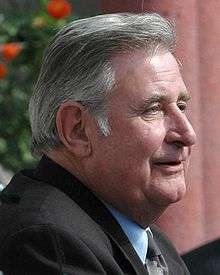Alberta general election, 2001
| | |||||||||||||||||||||||||||||||||||||||||||||||||||||||||||||||||||
| |||||||||||||||||||||||||||||||||||||||||||||||||||||||||||||||||||
| |||||||||||||||||||||||||||||||||||||||||||||||||||||||||||||||||||
| |||||||||||||||||||||||||||||||||||||||||||||||||||||||||||||||||||
The Alberta general election of 2001 was the twenty-fifth general election for the Province of Alberta, Canada. It was held on March 12, 2001 to elect members of the Legislative Assembly of Alberta.
The incumbent Alberta Progressive Conservative Party, led by Ralph Klein, won a strong majority for its tenth consecutive term in government. In addition to increasing its share of the popular vote to almost 62%, the PC Party won a majority of seats in Edmonton for the first time since 1982. In the process, they reduced the opposition to only nine MLAs in total. It was the Tories' biggest majority since the height of the Peter Lougheed era.
The Liberal Party lost 11 seats and ran up a large debt. Its leader, Nancy MacBeth, was defeated in her riding.
The New Democratic Party, led by Raj Pannu, hoped to make gains at the expense of the Liberals in Edmonton and replace them as the official opposition. This did not materialize, but the party did manage to maintain its share of the popular vote and held onto their two seats in the legislature. The NDs attempted to attract young voters with the slogan, "Raj against the Machine".
The right-wing Alberta First Party, contesting its first election, failed to win any seats or come close. The Social Credit Party, led by James Albers, was unable to build on its moderate success in the 1997 election, and sank back into obscurity. Socred leader Lavern Ahlstrom, however, performed well in Rocky Mountain House and finished second behind the incumbent Ty Lund.
Results
Overall voter turnout was 53.38%.[1]
| Party | Party leader | # of candidates |
Seats | Popular vote | |||||||
|---|---|---|---|---|---|---|---|---|---|---|---|
| 1997 | Dissolution | Elected | % Change | # | % | % Change | |||||
| Progressive Conservative | Ralph Klein | 83 | 63 | 64 | 74 | +17.5% | 627,252 | 61.91% | +10.74% | ||
| Liberal | Nancy MacBeth | 83 | 18 | 15 | 7 | -61.1% | 276,854 | 27.33% | -5.42% | ||
| New Democrats | Raj Pannu | 83 | 2 | 2 | 2 | - | 81,339 | 8.03% | -0.78% | ||
| Independent | 29 | - | 1 | - | - | 10,528 | 1.04% | +0.93% | |||
| Alberta First | John Reil | 16 | * | - | - | * | 8,851 | 0.87% | * | ||
| Social Credit | Coalition[2] | James Albers | 12 | - | - | - | - | 5,361 | 0.53% | -6.31% | |
| Alberta Party | Fred Schorning | ||||||||||
| Green | David Parker | 10 | - | - | - | - | 2,085 | 0.28% | +0.17% | ||
| Communist | Naomi Rankin | 2 | - | - | - | - | 117 | 0.01% | x | ||
| Vacant | * | 1 | |||||||||
| Total | 318 | 83 | 83 | 83 | - | 1,013,152 | 100% | ||||
Notes:
* Party did not nominate candidates in the previous election.
x - less than 0.005% of the popular vote.
Members elected
For complete electoral history, see individual districts
References
- ↑ Election Alberta (July 28, 2008). 2008 General Report (PDF). p. 158. Retrieved April 29, 2011.
- ↑ "Political parties to merge". CBC News. February 7, 2000. Retrieved May 29, 2011.
| ||||||||||||||||||||||

